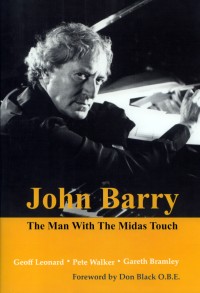Eileen Farrell & Robert Farnon Spring 1990 London Sessions
Twenty years ago "Journal Into Melody" celebrated its 100th issue – increased in size to 56 pages for the special occasion! The September 1990 issue was actually number 100, and in his editorial the Editor (guess who it was) wondered if we might reach issue 200 in 2015. It could actually happen in June 2014, but we won’t cross our bridges just yet.
Among the special features back in 1990 was a detailed report on the Robert Farnon sessions at CTS, Wembley, when Bob accompanied Eileen Farrell in the first of three CDs they made together. The album was called "This Time It’s Love" and it was released on Reference Recordings RR-42CD in 1991. The orchestral recordings took place at CTS on 30 April and 1 & 2 May 1990. Eileen sang with the orchestra on four of the tracks, but for the remainder her vocals were dubbed later back in the USA.
Twenty years on we are pleased to let you see many photos from the sessions, never previously included in JIM, together with the reports that appeared in our magazine:
EILEEN FARRELL & ROBERT FARNON
SPRING 1990 SESSIONS AT CTS WEMBLEY
The omens were good. Monday 30 April, according to the weather forecasters, was likely to be one of the warmest April days on record in England. It was. It also proved to be a day on which some of the finest Robert Farnon sounds ever were to he heard at the CTS Studios in Wembley.
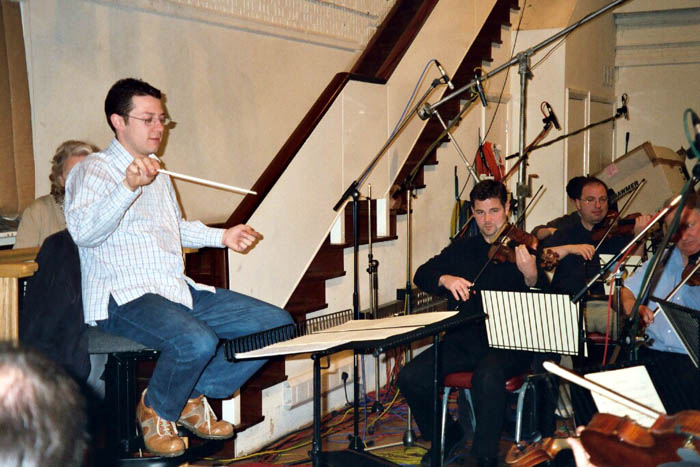
After originally being scheduled for San Francisco, then switched to New York - the eagerly awaited Farnon sessions with Eileen Farrell finally transferred to London’s CTS Studios on 30 April and 1 & 2 May 1990. The results delighted every one concerned - performers, producers and privileged onlookers, including those members of the Robert Farnon Society who were able to get along to the Studios.
To kick-off our reports on the Wembley sessions, we’ll hear from our first man on the pitch ... VERNON ANDERSON:
On a beautiful late Spring morning I made my way to the CTS Studios, for what was to be my second visit there both to see and hear Robert Farnon in action before a large orchestra. Today he would be recording with Miss Eileen Farrell, well-known in the United States of America for her operatic singing, but more recently venturing into the realms of popular music with some fine recordings of a selection of favourite "standards" in the jazz idiom.
The day’s session was not due to begin until 1 pm, but I arrived early so that I could experience all the work that precedes an occasion such as this. This decision proved well worth the effort. I made myself known to the Receptionist, who just happened to be talking to Miss Farrell’s Production Manager for the sessions. I was greeted warmly and made to feel very much at home. Studio No. I was the venue for today, so I made my way downstairs to see how the preparations were going, drawn by the sound of some not unfamiliar phrases being worked out on a piano. On reaching the doorway I had quite a surprise. I recalled that on the occasion of my last visit in May 1986 the studio had been partitioned off into small compartments, each containing different sections of the orchestra. Now, all this had gone, so as to provide one large space. The orchestra’s chairs were set out in a large semi-circle facing towards the right-hand wall and centred on the conductor’s rostrum, which was a raised platform ensuring that all would see him and he could see everyone else. Suspended above were the microphones and lights, with some floor standing microphones suitably placed around, The rostrum also housed a control panel with an audio link to the main control room upstairs, whose large soundproofed tinted glass window overlooked the studio.
The recording engineers were busying themselves, monitoring the piano to get the right sound balance in audio link from the control room to the pianist, with various instructions and comments passing between them and these beautiful musical phrases rippling around the studio. I just stood and listened, trying to take it all in.
I made my way up to the control room and there was introduced to other members of the production team and the recording engineers. Lastly to Miss Farrell, who proved to be a delightfully down to earth lady, who proceeded to tell me about her journey over from the States the previous day, her hotel etc., but most of all how much she was looking forward to meeting and making this recording with Robert Farnon, a man whose music she much admired. I asked her what her favourite piece of Farnon music was and immediately she recalled the "On Target" album which Bob recorded with jazz pianist George Shearing. In particular she loved his rendition of "Song Bird", a piece composed by her accompanist Loonis McGlohon, the gentleman I had seen in the studio. He joined us in the control room and I was delighted to be introduced to him. A very modest man, quietly spoken, who was also much looking forward to working with Robert Farnon. He, too, was delighted with Bob’s arrangement of "Song Bird".
So with a sense of anticipation, we made our way down to the studio, Miss Farrell wanting to get the feel of the place and see where she was to be positioned, etc... The recording booth was immediately to the left as one entered the studio, with glass fronted partition, but open each side, complete with chair, music stand, headphones and microphone.
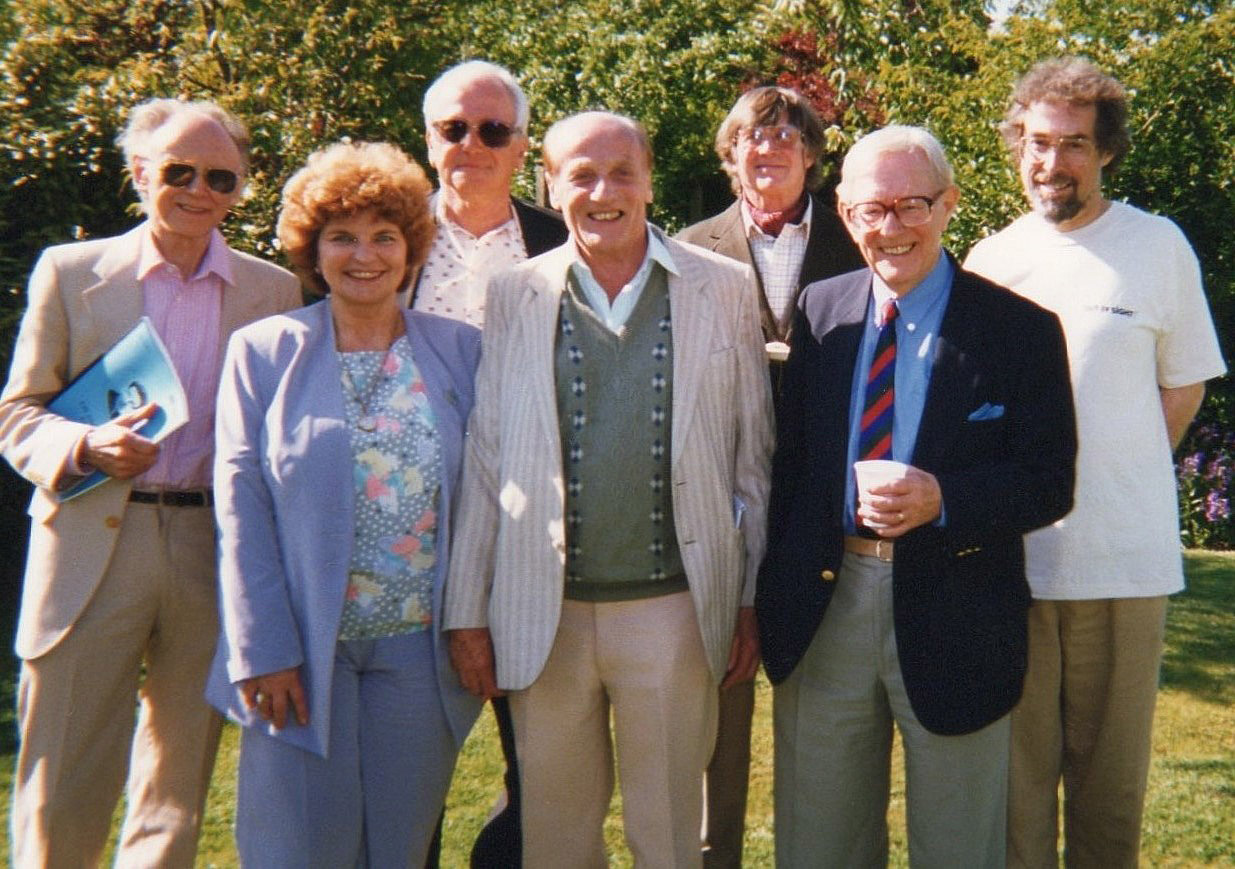
While all this was going on, I heard a familiar voice followed by first the feet and then the familiar figure of the man himself, as he came down the stairs to the studio. Robert Farnon greeted me warmly and asked whether David Ades had arrived. I assured him that David was on his way and I hoped he would be joining us for lunch. Bob asked if I would be writing an article on the sessions for the magazine, and I said I would. He was then introduced to Miss Farrell, who was immediately at ease with him, and they talked about the day’s programme. Then Bob met Mr. McGlohon. They discussed the schedule, which was to include another piece composed by him called "Everything I Love". Bob also met the recording engineers who discussed the layout and sound balance with him. Anyone who has had the pleasure of meeting Robert Farnon will know that he has this marvellous reassuring nature, is very unassuming and has a great sense of humour. These qualities revealed themselves as the day’s programme progressed. But it was now time for lunch, so I made my way upstairs to the restaurant on the second floor. This has a bar, and a long balcony with views west to the Conference Centre and beyond. The weather was fine, sunny and unusually hot for the time of year. I met Derek Boulton, Bob’s agent and manager, who generously treated me to a lunch. He asked me to join him at a table with Miss Farrell and Mr. McGiohon but I declined, saying that I thought Bob would want to discuss arrangements with them, so I sat at a table adjacent to them and started my meal. Bob Farnon came over with his lunch and said "I don’t like to see you eating by yourself, mind if I join you?" That is typical of the man, and that gesture made my day. We were joined by Bob’s son David, who would be assisting in the production and also playing with the orchestra in several pieces. Altogether a very enjoyable meal.
The lunch over, we made our way first to the control room, where we were joined by David Ades and then to the studio where the musicians were assembling ready for the afternoon session.
In true Farnon fashion, the rehearsal began at 1 pm sharp, the first piece on the stands "My Romance" with Eileen Farrell ‘singing in’ with the music. A lovely arrangement by Bob, and what a joy to hear the full orchestra playing it live. David Ades and I were standing just inside the doorway adjacent to Eileen’s booth, catching every note and colour. The stuff that dreams are made of.
The second piece - "Alone Together’ by Arthur Schwartz opened with a trombone solo from top session musician (and bandleader in his own right) Don Lusher, with a reference at beginning and ending to Bob’s orchestral score on the "Something To Remember You By" album of the 1950s.
No. 3 - "More Than You Know" by Vincent Youmans. This time a vocal intro, with the verse played by orchestra and solo from Don Lusher. The closing bars made reference to Bob’s "Prairie Sunset" (also known as "Almost A Lullaby").
No. 4 - "Everything I Love" by Loonis McGlohon: a new piece, with an intro, by Bob reflecting "Something to remember ..." and closing with a reference to ‘Pictures In The Fire". A beautiful arrangement.
At 2:45 No. 5 - "My Foolish Heart" was on the stands, with the intro, reflecting Bob’s earlier orchestral arrangement and closing passage from "Lake Of The Woods" with flute solo, followed by
No. 6 - "The Nearness Of You" by Ray Noble. Bob made an orchestral recording of this one back in the 1950s and later with vocalists Ray Ellington and Sheila Southern. Today we were treated to a new arrangement of this ‘standard’ which was very beautiful.No. 7 - "Easy To Love" with a hint of Bob’s ‘Hits Of Sinatra’ album’s "Second
Time Around". An up-tempo number with the great Lenny Bush on rhythm bass and Martin Taylor on guitar.
The time 3:40 and No. 8 — "The More I See You" was on the music stands. A marvellous up-tempo arrangement by Bob which had Eileen Farrell swinging along, showing how well she can sing in the jazz idiom. I particularly enjoyed her phrasing on this one.
3:49 - and it was time to start recording. So with take 1 Bob swung the orchestra and Eileen into "The More I See You" again. I noted a particularly fine tenor solo from Tommy Whittle. By the time everyone was satisfied, it was time for tea in the restaurant, where David Ades and I were joined by Bob and son David. Bob seemed quite pleased with the way the sessions were going. There was even time to enjoy the afternoon sun on the balcony.
At 5:00 pm the sessions resumed with "My Romance’. The fourth take commencing at 5:30 was fine and, as the expression goes, ‘in the bag’. At this point I’ll hand over to David Ades to tell you about the remaining magical moments of the evening session. VERNON ANDERSON
Vernon’s report above graphically conveys the atmosphere at the studios, and the business-like way in which the sessions proceeded. My overwhelming impression of that first afternoon was the sheer joy of hearing that magnificent orchestra (all hand-picked session musicians) glide almost effortlessly through no less than eight stunning new Farnon arrangements within three short hours. There is very little I can add to Vernon’s comments, except to tell you that I detected Bob’s First Symphony briefly appearing in "The Nearness Of You"; he also used the same theme in his "New Horizons".
Although there were a few changes on the final day, on most numbers the orchestra comprised: 10 first violins (leader, Raymond Cohen); 8 second violins; 6 violas; 3 bass; 3 french horns; 2 trombones; 4 woodwind; harp; piano; bass and guitar.
Now to return to the evening session on the Monday. Following "My Romance", at 5:32 the orchestra played "Alone Together". Certain instrumentalists need their own headphones so that they can hear the singer, and ensure that their own solos or accompaniments fit in neatly with the rest of the orchestra. During this number certain problems arose in this respect for the harp, and Martin Taylor’s guitar passage at the end. But in typical Farnon fashion all such matters were quietly resolved with good humour, and by 6:00 the orchestra were ready for the next tea-break.
By 6:35 the orchestra were gently swinging "Easy To Love", much to everyone’s enjoyment. Bob suggested that they should up the tempo a little, which made the arrangement really sparkle. But while the increased tempo sounded fine from the orchestra, it didn’t really suit the singer; it was decided that this number should proceed at a more leisurely pace, and the final result was much to every one’s satisfaction.
Soon after 7:00 they went back to "Alone Together" because it was felt that they could still improve on earlier efforts. Not infrequently the crew think that a number sounds fine - until Bob declares that this and that were not quite right, and invariably he is proved correct. By 7:22 they were happier with the results, and Bob then turned his attention to the new Loonis McGlohon number "Everything I Love". Given the necessary exposure, this lovely melody could well become a modern standard. This performance was given added poignancy by the composer’s participation at the piano. By 8 pm everyone agreed that the long day had been a great success; in particular Eileen Farrell and her American companions seemed knocked out by Bob’s arrangements.
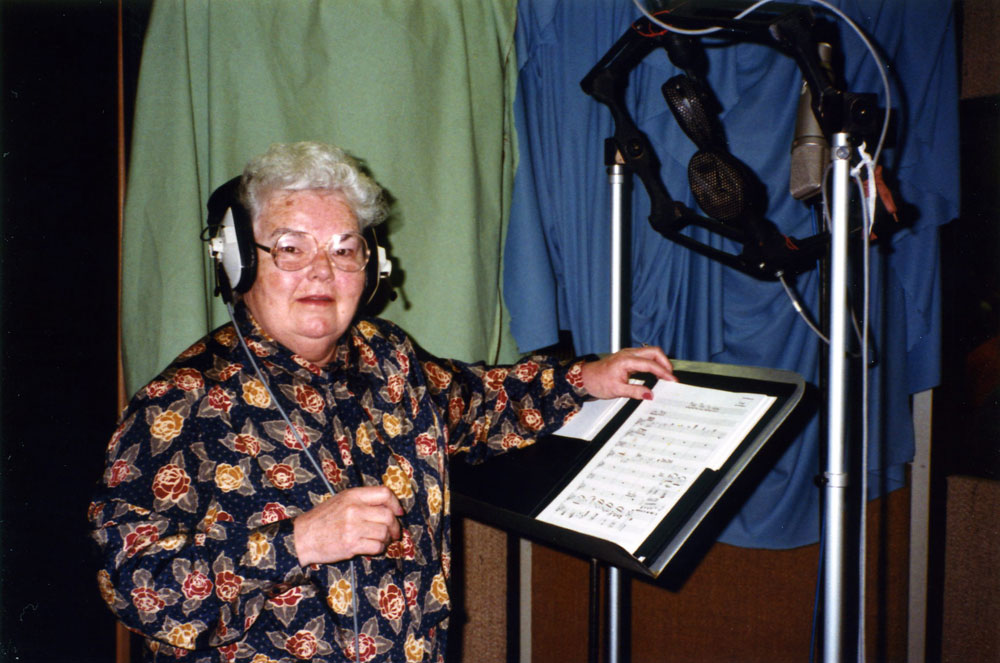
May Day dawned, with more temperature records being broken. Fortunately minor problems with the air conditioning were quickly corrected! And some new faces appeared at the studios. On the Monday, Frances Carder had looked in during the afternoon, and Tuesday saw the arrival of Beryl Antony, Don Furnell and Cab Smith joining the RFS ranks. Cab has reported on the remaining sessions for us (below) so I’ll close my own remarks with just a few observations. We were a little surprised at first on finding that the orchestra did not include any trumpets or percussion. Bob decided that they were not essential, and "Easy To Love" in particular illustrates that an orchestra can swing without them - at least, in Bob’s hands. On the technical side, the sound engineers used only a small part of the elaborate facilities available to them in the CTS Studios. Remember, these are the same studios where John Williams and many other leading film composers have recorded their soundtrack scores, needing state-of-the-art technology. But the experts at Reference Recordings like to use their own equipment, which even extends to employing different circuitry for CDs and vinyl, to match the differing requirements of digital and analogue sound. The intention was that Eileen Farrell would sing each number in the studio with the orchestra, rather than weeks or months later in a remote studio elsewhere. Unfortunately her booth caused relationship problems between herself and the orchestra which her headphones could not adequately remedy. It is likely that she will dub in a few of her vocals which did not satisfy her high standards. "My Foolish Heart" was one number where Eileen was particularly unhappy with the results being achieved. DAVID ADES
Now let’s read CAB SMITH’s impressions on his two days at Wembley:
Once again I had the great pleasure of attending another of Bob’s recording sessions, which took place at C.T.S. Wembley over three days from Monday 30 April - although we rounded off at 12:30 on the Wednesday.
The event was a series of popular songs from the past, sung by a charming lady from the States who sang with a most pleasing voice which came over most clearly on all of her songs. If I recall correctly, she sang in a similar style to Kate Smith, who I used to hear on some of her radio shows aired on A.F.N. in Germany back in the late l940s. Eileen did admit that she had been around singing after the war, so you can gather from that she has covered a great number of songs in her time.
Unfortunately I could not attend the Day 1 sessions, but I could not wait for Day 2 (Tuesday 1 May) to arrive. So after travelling for an hour and three-quarters, on a journey that usually takes about forty minutes, I finally made it - NOT the fault of my Lada, as some people may have thought!
I arrived at 10:15 am and made my may to the control room, where I was greeted by David and Don Furnell and, of course, the Guv’nor himself looking very well. It was also good to meet David Farnon again, who had his hands full keeping tabs on the cue sheets, etc... I just arrived as they were listening to the playback of a song from the 1930s "More Than You Know". It was originally featured in the film "Hit The Deck" with Jack Oakie, with a remake in 1955 by MGM. After three takes everyone seemed happy with the result, Then on to the next number "The Nearness Of You" by Ned Washington and Hoagy Carmichael, from the 1938 picture ‘Romance In The Dark". Again, this was very nicely sung.
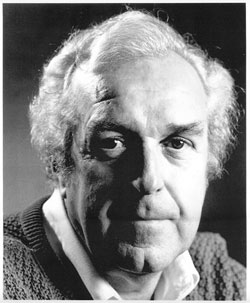
The following piece was entirely new to me , "What Is There To Say" ... once more, a beautiful performance by Miss Farrell after three takes.
Song No. 4 "Love Panic", I must admit, was completely new to me as well. But again it was nicely put over by Eileen. Throughout the session, at times Don, David and myself would go down on the studio floor and sit at the rear of the orchestra. What a treat, being among the cream of the orchestral world Raymond Cohen, first violin; Don Lusher, trombone; Lennie Bush, bass; Roy Willox, Tommy Whittle, reeds; Martin Taylor, guitar; along with around 50 session personnel. This is where the real atmosphere of the orchestra was! And I mustn’t forget Bob, out in front conducting his wonderful arrangements which clearly appealed to the musicians on that enjoyable session.
Then the lunch break arrived, so most of us trooped off to the studio restaurant, to enjoy a first class meal, at their price!
Two o’clock arrived, and we returned to the control room to await the next ballad to be rehearsed. It was a number that became a big hit way back in 1949 "My Foolish Heart", composed bv Victor Young with words by Ned Washington. This took a little longer to rehearse, as by now Eileen Farrell’s voice was starting to get tired, so she decided to sing it again the following day. She tried out the next number on the schedule, which she seemed to handle better - "His Is The Music That Makes Me Dance". Eileen performed this with great feeling and after four takes this led us up to 4:55pm. Everyone seemed to be happy with what had taken place, so after our farewells to all concerned my next move was to head the Lada for home.
Wednesday 2 May: Day 3. I arrived a little late for the final session, and greeting me as I entered the control room was Bob’s arrangement of "The More I See You" with Eileen handling the lyric with ease. This number was written by Mack Gordon and Harry Warren for the Billy Rose film "Diamond Horseshoe" starring Dick Haymes and Betty Grable in 1945. By 10:30 the song was in the can, as you might say, and then came a lovely ballad which Frank Sinatra used to sign off his radio show back in the 1940s. "Put Your Dreams Away", again very nicely put over, and after a few takes everyone was satisfied.
Break time came for twenty minutes, giving us a chance to check the weather outside which was still outstanding for the time of the year. Then back to the control room to hear another run-through of "My Foolish Heart", postponed from the previous day. After another take it was decided to record an orchestral track only, so that Eileen could add her voice later if she wished.
About 12:15 the session came to an end, For me it was a most enjoyable two days listening to a great lady of song, whose diction is so clear that every words of the lyrics comes through. As for today’s vocalists ... you often wonder just what they are singing! My thanks to Bob and David Farnon for letting us sit in at the sessions, and let’s not forget Bob’s manager Derek Boulton for helping to make it all possible.
An afterthought: looking through my ‘Hollywood Musicals’ book I see that, in 1955 MGM produced a film called "Interrupted Melody". It was the biography of Marjorie Lawrence, a well-known opera singer played on screen by Eleanor Parker co-starring Glen Ford. The entry states that Eileen Farrell dubbed the songs for Eleanor Parker, and from reports she was rated very highly for her valuable contribution towards the film’s success.
CAB SMITH
The photographs in this feature were taken on 1 May 1990.


